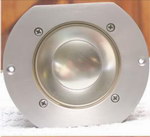Having collected most drivers and horns for a pair of 4345 clones, (2245H, 2420 and HL91 horn-lens.) I found a pair of LE10H-1 10 in. in need of surrounds. I also purchased a pair of 2404H tweeters. I am mostly concerned about the differences between the LE10H and 2122. I know that the LE10 is less efficient but I will tri-amp the low, low-mid and mid-high. I'll worry about the super-high later. I think that it's worth a try. Any and all comments will greatly appreciated. Thanks.



 Reply With Quote
Reply With Quote




